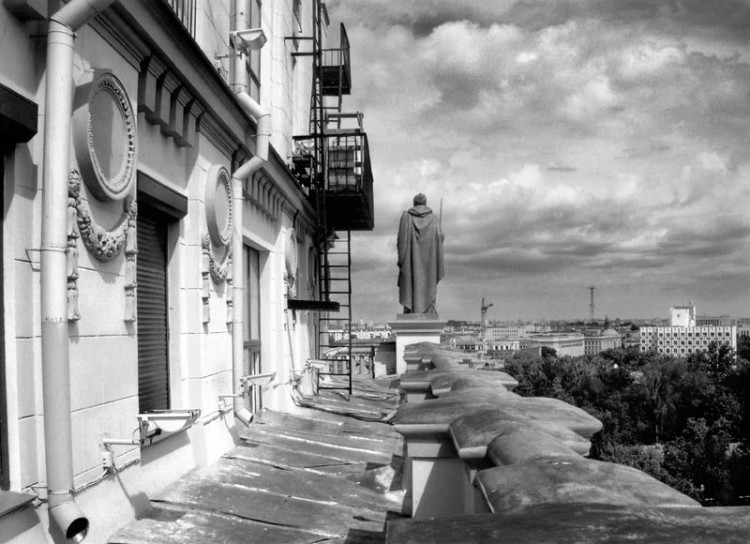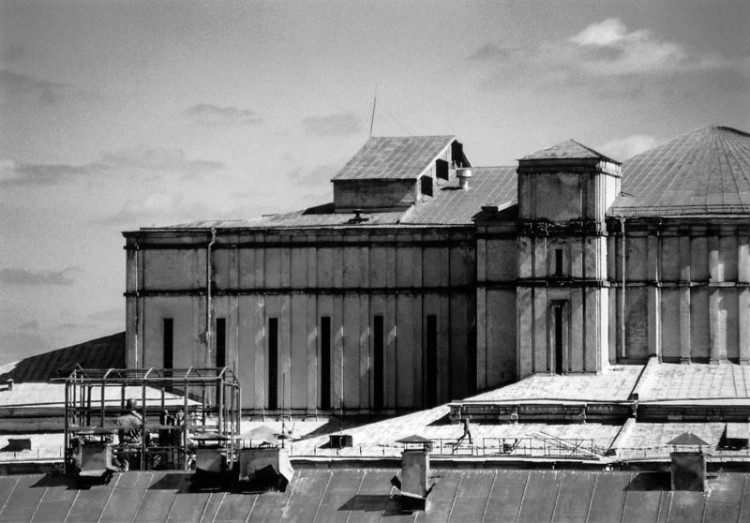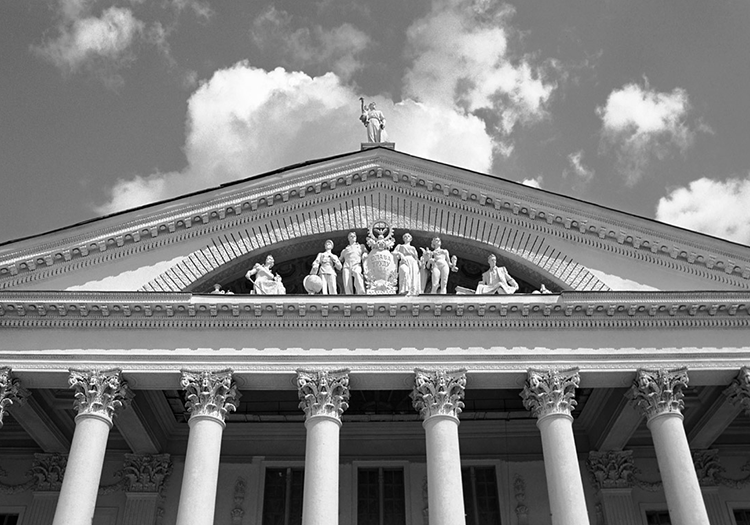The Sun City of Dream is a conceptual project by Artur Klinau which consist on two parts: A visual poem The Sun City of Dream (photo series 2002-2005) and a novel Minsk. The Sun City of Dream (2006).
***
About 500 years ago, the English writer Thomas More wrote his “Utopia”. After nearly a century Italian priest Tommaso Campanella has created a philosophical work “The City of the Sun”. Both novels embodied the great dream, which is based on the idea of the possibility of establishing a society on the ground of universal happiness, social harmony and justice. After 400 years, Belarusian artist Artur Klinau, based on the concepts of European thinkers, created his artistic conceptual project “The Sun City of Dream” which includes of a photoseries — visual poem “The Sun City of Dreams”, and a novel “A Small road-book through The Sun City of Dreams” (“The Sun City of Dream”) about Minsk (translated on German, Polish, Swedish, Hungarian, Russian).
Artur Klinau: “The Sun City of Dreams” is a unique Minsk urban ensemble of 30-50s of 20 century, which is valuable because of its integrity. You can have different attitudes to the ideology, but we have to admit that it is a monument to the Great Utopia, and a monument to culture and world civilization. The communist project was not only a project of the Soviet Union. It’s a European project. He was born in Europe 500 years ago, and here was implemented in this way. Therefore, “The City of the Sun” is a European monument, and only we in Minsk have it”
READ the interview with Artur Klinau about The SunCity of Dream-2 project.

Artur Klinau Guards \ The Sun City of Dream Series
From the essay by Artur Klinau
On his first visit to Minsk a European cannot but be fascinated by the city’s strange yet actually irresistible charm. What strikes the tourist is the imperial city aesthetics, a phenomenon, which is quite rare in Europe. Wide streets and avenues, lots of palaces, adorned with a bit odd but still lavish decoration and numerous vast parks in the city centre are really a kind of luxury for European cities, which could only be afforded by very rich and aristocratic ones.
However, Minsk in its monumental form does not look absolutely cold, hostile or domineering but is touched by some delicate air of provincial sentimentalism. For European architecture nothing could be more out of the ordinary than sentimental empire style. Imperial city space, which by definition should keep the individual at a distance, in Minsk is all of a sudden split, to become close to and congruous with humans. Just like in Lewis Carroll’s Wonderland, mighty architectural structures shrink to the size of a doll’s house and then mushroom to elephantine proportions again. The scenery keeps changing all the time. A gorgeous, splendidly decorated arch leads you into a shabby-looking inner yard with lines of tiny little booths instead of balconies as the only decoration on its unplastered walls. Another two hundred metres – and another monumental arch shows you the way out of this feast of wretchedness into another huge square, where gigantic Corinthian columns will march along the pavement, making passers-by look like Lilliputians. Rhythms, aesthetics, psychological moods constantly changing, the city space develops plenty of irrational and illogical zones, which remind you of Franz Kafka, Elias Conetti or Daniil Kharms and even make you feel as if you were a character from their books.
There are only a few imperial style cities in Europe: Paris, Berlin, St.Petersburg, Vienna, Rome and then… Minsk! But Paris, Berlin or Vienna used to be either major imperial cities or centres of great political, economic or cultural trends, whereas Miensk has never been a more or less noticeable centre of any of these processes, to say nothing of an empire, even a second-rated one. It took less than a century for a small provincial town, hardly visible on the map of Europe to turn into an enormous by European standards two-million megalopolis, wearing lavish, even if a bit weird robes. The miraculous transfiguration was entailed by some mystical genius loci. It logically arose from a mythologeme, which can be traced centuries back.

Artur Klinau A Man Walking on the Roofs of the Sun City of Dream \ The Sun City of Dream Series
“A city of perished heroes”, “a city of dead poets”, “a city of deceased geniuses”, “a graveyard of a city” — all of us have heard such definitions of Minsk more than once. One could discard them as a poetic metaphor, were they not so utterly true. Indeed, Minsk is a dead city or the city of the dead or rather the city of dead cities. Throughout its history, the site has seen more than one Miensk come into being and vanish off the face of the earth. At different times, it used to be Orthodox, Roman Catholic, Uniate or Greek Catholic, Judaic, Orthodox again, then Soviet, Sarmatian, baroque, imperial and a provincial centre. What makes Miensk so special is its amazing line of incarnations. Every time it rose from the ashes, Miensk broke with the past tradition to be revived as a totally different city with new aesthetics, life style, mythology and even ethnic and religious composition. It looked like several waves of nomads would settle here, build their towns and then move on, taking their towns with them, leaving behind but the trash of cultural layers, energies concentrated somewhere deep inside and their ancestors’ remnants cast all over the surface of what was once a town.
This is typical not only of Minsk but also of many other Belarusian towns and cities. They differ by the number and aesthetic value of their reincarnations. Some disappeared, never to be revived again. Others were restored, but in such a fashion that I would rather they had not.
In terms of history death and resurrection make the algorithm for the whole of the territory that in its present reincarnation is called Belarus. Luckily or unluckily (this can only be clear in a few centuries), it is situated on the borderline between the two great civilisations, rather than within the domain of either one. This accounted for both its inevitable death, when the waves from the East and the West would beat against each other, and resurrection when the times of peace required ports and quiet havens. Perhaps this is why reincarnation or revival has become the key to understand Belarusian history and a magical symbol of Belarusian destiny.
Every normal European town or city develops by adding what is new to what has long been existent. This way it evolves, varied cultural layers overlapping all the time. Even if new nations took over old ones, they adopted the previous dwellers’ legacies to add something of their own. As for Minsk, which significantly enough commenced its recorded history with bloodbath on the Niamiha banks, it has turned into “a city of dead cities”, “failed civilisations”, “perished heroes” and their nations. Yet, this was precisely what made an ideal place for an Ideal City of the Communist Utopia. It was predetermined by its mystical fate that the happy Sun City of Soviet Dreams was to arise here only. The undertaking would have failed in Moscow, which was the heart of the empire, or Leningrad or any other town or city. Take Moscow, for example. For generations Soviet architects endeavoured to turn it into the Sun City of Dreams, yet, it still remains an enormous eclectic conglomerate. It is in Minsk only that the Sun City of Dreams could become a reality, for it needs a vast graveyard of dead cities, where the mournful Sun lights the Dreams of the Dead.
Every state has its coat of arms, anthem and flag as its symbols. So does every social Utopia have its Ideal City as its symbol. Any Utopia is an attempt to make everyone happy. Its Ideal City is to represent the aesthetic of Happiness as figured out by the founders of the Utopia. In the state of workers and peasants the aesthetics of Happiness was associated with what the oppressed classes had been deprived of. Their idea of wonderful life and well-being presupposed that a man of the communist future instead of slums was to reside in magnificent palaces with beautiful parks, fountains and perfect statues. These were to represent the beauty of a harmonious man of the communist future. The palaces were to be linked with one another via wide streets, lined up with green trees and exotic flowers. The Ideal City was to have grand squares at its key places, where happy citizens would come together for exciting celebrations and parades. It is this very concept of the Sun City of Dreams that has been carried out in Minsk’s post-war reincarnation.

Artur Klinau Gods \ The Sun City of Dream Series
Stalin – Lenin (now Skaryna) Avenue has become the city’s main throughway. It is one of the longest in Europe, from 12 to 18 kilometres in length at different times. There are a number of gigantic squares going along the city’s axis in a cascade: Lenin (now Independence) Square, Stalin (now Kastryčnickaja) Square, Victory Square, Jakub Kołas Square, Kalinin Square… The main throughway is lined up with endless rows of the famous Miensk palaces, designed by the best Soviet architects of the time.
The unique edifices, which could be defined as “popular palaces” are not in fact palaces proper. Borrowing from the classical palace its lavish exterior decoration, inside they remained just ordinary blocks of flats. Each of the palaces had a little park in the backyard as a rule, with statues, sometimes fountains and even open-air stages. In a way the style of Minsk palaces can be described as “Stalin’s empire”, which is actually decadent, differing from the laconic classical empire style by indiscriminate use of architectural signs of the past. The builders of the Great Utopia had no doubt that their aesthetics of Happiness should comprise all the highest achievements of pre-communist culture. No wonder then that Stalin’s empire style in its semantics covers the whole scope of classical architecture, applying ancient Greek, Roman and even Egyptian models alongside baroque and Renaissance motifs.
The “popular palaces” are simply signs to symbolise palaces. This is what makes them so unique. The edifices actually make an illusion of palaces, where the sumptuous façade decorations are artificially fastened to constructivist walls. As if drawn on one side of a sheet, the decadent splendour is gone once you turn the page over. The infinite rows of flat palaces, which are actually nothing other than scenery for some grand performance, make a fascinating surreal sight. But as soon as you step sideways, you find yourself in a completely different reality. The Corinthian and Ionic orders, imposing cornices and monumental arches evaporate in a wink of an eye. What remains is grey unplastered walls, piteous balconies with laundry hanging on the washing lines and monotonous barracks-like black windows. This is what the naked truth is all about. Some people, who resemble Brueghel’s characters rather than happy residents of the Sun City of Dreams are trudging through there, burdened with their little dramas. Among these backyard parks the dramas sound louder than on the other side of the wall, where they are muffled by the march of Roman columns, Egyptian obelisks, Greek urns and vases and some stone divinities of the communist mythology, which proclaimed general happiness.
There are only a few palaces that do not fit into the definition of “flat palaces”, such as the Palace of Post, the Palace of the Government, the Palace of the KGB, the National Bank Palace, the Trade Unions Palace, the Palace of the Party’s Central Committee, the Palace of the Republic, the Circus Palace, the Academy of Sciences Palace and maybe just one or two more.

Artur Klinau Academy of Sciences / The Sun City of Dream Series
In their eclectic Minsk palaces sometimes take on so surreal and hyperironical forms as to be envied by the fathers of postmodernism. Take, for instance, the Television Palace in Kamunistyčnaja (Communist) Street. The imposing colonnade in ancient Egyptian style is stuck to an ordinary constructivist façade, out of which a Renaissance pediment grows quite hesitantly, as if it were ashamed of something. Or have a look at the Belbusinessbank building in Marx Street, hardly noticeable at first sight. Its constructivist façade is decorated with several tiers of thin and delicate Corinthian columns. Really, it is the last thing to have been expected here. To crown it all, this sample of absolutely illogical architecture is adorned with stone flowers enwreathing the front door in some baroque rhythm.
The further you go from the main throughway, the more frequent are samples of irrational and illogical architecture. The painter who was creating this masterpiece seems to have worked thoroughly at the central part of the composition, leaving the rest in the form of a sketch with just a few random expressionist strokes, prompted by his subconscious. In place of the flat but still integral scenery now come separate fragments. The “wall-like” palaces give way to what can be called “window-like” palaces. No longer producing an illusion of a palace, the buildings are now merely labelled with some symbolic sign to represent a palace. The label can take the shape of a few ornate windows, a pediment or some columns, often stuck to unplastered walls, where they are really out of place. By the way, you can see the same kind of labels on the back side of the “wall-like” palaces as well.
It all gives you an impression of grand-style scenery for some strange production. The sets substitute for reality. The Sun City of Dreams in fact turns out to be a flat imitation, where the sun is but a plywood circle, painted bright yellow. Abundant in spaces between the palaces, the statues of perfect people, including athletes, replicas of Greek sculptures, girls carrying oars, pioneers alongside bears, deer and other wildlife as symbols of coming at one with nature in the Communist Paradise, are actually mere plaster models. This is a good excuse for real imperfect people profaning them, breaking off their arms and noses, covering them in paint and writing foul words on them.

Artur Klinau Towers in the Rain / The Sun City of Dream Series
No Utopia can become real. So the project to build an Ideal City of Communist Happiness in fact has turned into the Sun City of Dreams, flat scenery for a pastoral play in absurdist style. But this may have been exactly what the playwrights intended to do. After all, the true Sun City of Dreams was to be constructed further eastwards, in Moscow as the imperial centre. Miensk was only its front gate. The audience that the splendid scenery was designed for could not have noticed it was all imitation. For the real audience were tourists entering the Empire through its monumental triumphal arch, not people living in the beautiful“wall-like” or “window-like” palaces. Passing the imperial triumphal arch, i.e. the One-Street City of two palace walls stretching for kilometres, the tourist was supposed to kneel in the face of the Empire’s grandeur. It may seem a paradox, but Minsk as the triumphal arch became the Empire’s more impressive aesthetic symbol than the centre itself. Moscow failed to overcome the resistance of its mentality in order to represent the highest altar of the Soviet Empire.
Minsk as the Sun City of Dreams that has emerged among Belarusian woods and bogs is a practical outcome of the project aimed to create an Ideal City of the Great Communist Utopia. The fact that the project has been carried out within absurdist aesthetics and poetics and turned Minsk into an imitation of the Sun City of Dreams, does not by any means take away from its uniqueness. Minsk’s present reincarnation has in a way completed a certain mythological and poetic discourse. The ghost of the city is now dwelling in a body that in spite of seeming materially real turns out to be a ghost, a Shadow of the Empire, a city of an artificial sun and splendid theatrical sets. All the marvellous squares and wide streets lined up with the flat palaces are only a big stage prepared for acting out some weird play. Neither Belarusian nor Russian, neither Polish nor German, the universal play centres on human dreams and the impossibility to make them come true, the City of Happiness and the impossibility to get there. It is the myth of Sisyphus and the myth of Icarus, it is about the Sun, which brings life to all creatures and symbolises death.
Minsk with its ten centuries’ long history questions certain values. Which is better, uniqueness or warmth of cultural layers? Which alternative would be preferable: having been born once, to live a normal life of a typical European town, becoming cosy and dweller-friendly, but ordinary, or having been reborn and ruined over and over again, to turn into a bizarre architectural conglomerate, which is beyond any comparison? Which is more valuable: being normal or bearing a mark of genius, however pathological it may be? Mediocre philistine calm or an aspiration to create a great romantic Utopia, which has in the end taken shape of the absurdist Shadow of the Empire, named the Sun City of Dreams?
A dream is not death…
© Artur Klinau
© 2014 www.arturklinau.com. All rights reserved. For using texts from the site reference to the source is required. About using the images, please, contact arturklinau@gmail.com
